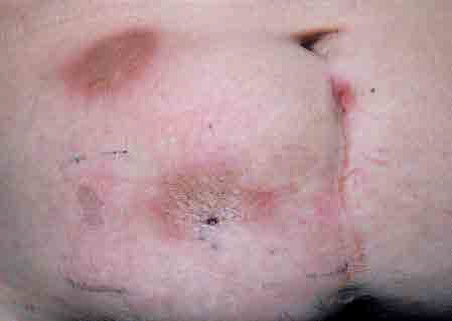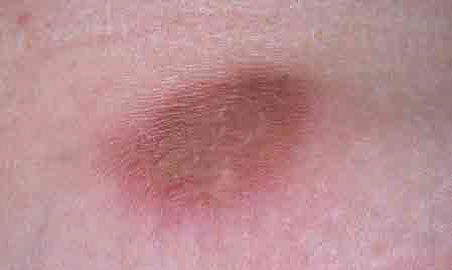
Panniculitis
Painful, erythematous plaques had erupted 4 to 6 weeks earlier on the left upper arm and lower abdominal wall of a 54-year-old woman. The lesions had since increased in size and become more tender. The patient reported no trauma, fever, chills, sweats, arthralgias, myalgias, or weight change. Her past medical history included embolic stroke, hypertension, and intravenous substance abuse. While taking warfarin 1 year earlier, she had been given one injection of vitamin K subcutaneously at each of the sites of the current lesions for a supratherapeutic international normalized ratio. Other than the plaques on her left arm and abdominal wall, physical examination findings were unrevealing. Complete blood cell count, chemistry survey results, and erythrocyte sedimentation rate were normal. There was no evidence of absolute or relative eosinophilia. An injection of triamcinolone into a single lesion failed to relieve the pain significantly. A 3-mm punch biopsy of one abdominal lesion was obtained. Histologic examination revealed dermal sclerosis and perivascular lymphocytic infiltrate extending into the subcutaneous tissue. The differential included morphea, lupus profundus, and injection site panniculitis. A diagnosis of vitamin K panniculitis was made.

Cutaneous reactions to vitamin K are rare, but a number have been reported, particularly in persons with underlying liver disease, such as cirrhosis, hepatitis, hepatoma, and Budd-Chiari syndrome. It is unclear whether the higher incidence of cutaneous vitamin K reactions in these patients is secondary to hepatic pathology or caused by the increased need to replenish vitamin K in advanced liver disease. Two classes of cutaneous reactions are known. The first is characterized by erythematous, indurated, pruritic plaques that occur 24 to 48 hours after vitamin K injection. This reaction is thought to be caused by a delayed-type hypersensitivity. The lesions resolve within weeks. The second class of reactions arises between 1 month and 2 years postinjection. The eruptions are described as sclerodermoid. Some sclerodermal changes associated with this type of reaction may fail to resolve. Some patients with this type of reaction do not experience pain. Surgical consultation and excision of painful lesions may be considered. This patient declined surgery and was referred to a pain management clinic.
Subscribe GP Clinics For Monthly Medical Journals Please Visit: http://www.gpclinics.in/
30 GP CliniCs Vol 7 no 10, January 2017